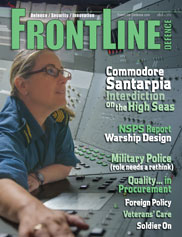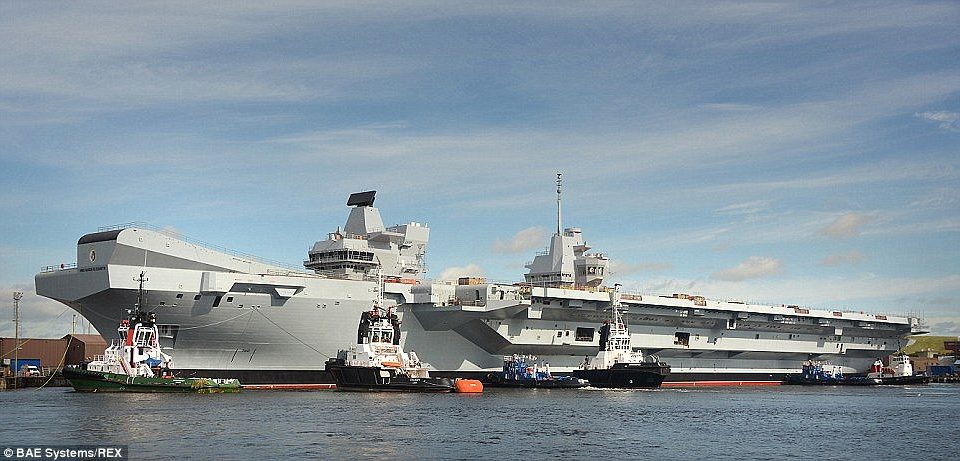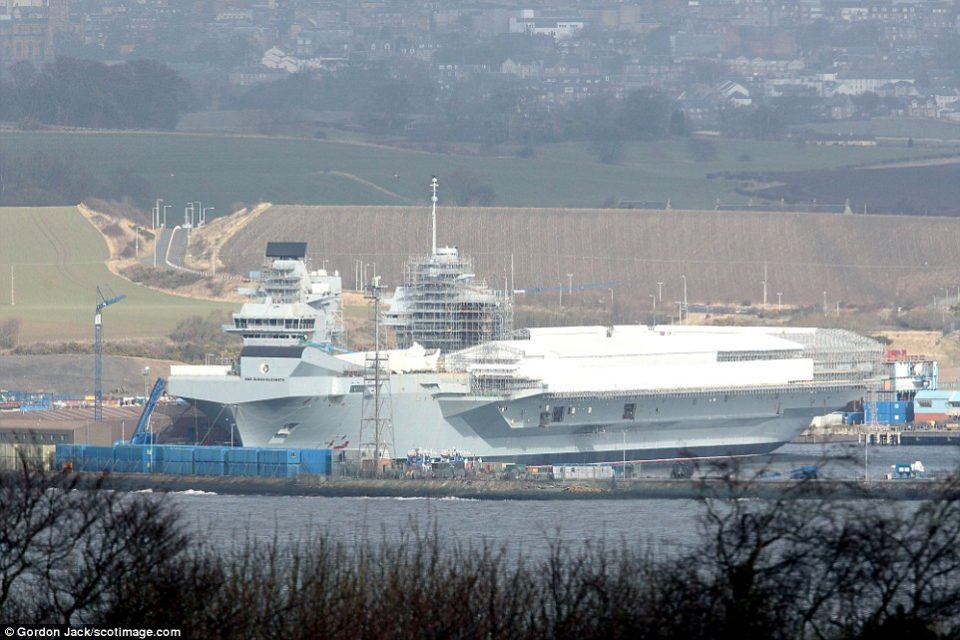2015-09-19 By Robbin Laird
© 2015 FrontLine Defence (Vol 12, No 4)

The British invented carrier warfare – and now, with their new Queen Elizabeth Class of carriers, they are working their own version of the 21st century strike carrier.
Using global lessons learned, they are reinventing the large deck carrier based on the confluence of a number of technologies (some similar to the USS Gerald Ford – CVN-78) and the impact of the F-35B (similar in some ways to the USS America).
Construction of the most complex warship ever built in the UK has reportedly sustained more than 7,000 jobs at more than 100 companies across the country.
The Royal Navy is currently preparing for sea trials in 2016, and flight trials with Lightning II Joint Strike Fighter aircraft after that.
In late March 2015, I had a chance to visit the first of class of the new generation British carrier, Her Majesty’s Ship Queen Elizabeth, and also passed by the rapidly emerging Prince of Wales, which is next in line. The day after the tour, I sat down with Royal Navy and Air Force senior personnel to discuss the way ahead from an operational point of view.
The first thing you notice when you get onboard is how large the flight deck is. I was told it is approximately 90% of the size of a Nimitz Class carrier (which is the largest warship in the world).
The second thing you notice are the two islands aboard the ship.
This is due to the fact that it is not a nuclear carrier and the exhausts for the engines exit on two parts of the flight deck – with an island incorporating those exit points. The forward island is used to operate the ship; and the aft island runs flight deck operations. In a crisis, either can perform both tasks, but in visiting the two islands, it is clear that the designers have focused on ways to enhance the work flow for the two different tasks, namely running the ship and operating the aircraft aboard the flight deck.
HMS Queen Elizabeth is a cross between the notion of a large deck amphibious assault ship, like the USS America, and a strike carrier, like CVN-78 or the USS Gerald Ford (when commissioned).
The ship is designed to handle 40 aircraft: fighters, helicopters, and possibly Ospreys in the future. The current plan is for 24 F-35Bs, 8 ASW helicopters and 5 Crowsnest surveillance systems off of modified Merlin helicopters.
The design emphasizes flexibility, with accommodation for 250 Royal Marines and the ability to support them with attack helicopters and troop transports up to Chinook size and larger. In addition to the innovative JSF F-35B, the Royal Navy will add a new airborne command post to the deck, which will be available for a multiplicity of tasks in ship defense.
With the F-35B, the strike concept will be different from that of the U.S. Navy and its large deck carriers.
As an RAF officer put it: “The plane is so easy to fly, we will focus on getting the maximum effects from the strike force, and not have to focus as much attention to flight choreography as one has to do with legacy aircraft.”
The focus is clearly on effects generated from an aircraft carried designed for 24/7 operation.
The F-35B launched from the carriers are part of the picture; the very significant Command and Control capabilities aboard the ship are another. With the carrier afloat, the RAF is looking to build synergy among the various land based and carrier based aircraft to generate combat effects.
As one Royal Navy officer put it: “The strike force could be commanded from the ship, from the ground or from the air. We are building flexible C2 to get maximum combat value from aircraft launched from the carrier.”
Several innovations one sees aboard the Gerald Ford can be found aboard HMS Queen Elizabeth: significant power generation, efficient C2 capabilities, very large rooms for reconfigurable C2 suites for operations across the Range of Military Operations (ROMO), and well designed work areas for the F-35B crews which will handle the operations and data generated by the fighter platform to the fleet.
Significant power generation means that future developments can be accommodated, including the probability of the coming of directed energy weapons. The ability to drive the computer power necessary for evolving C2 is significant as well.
Walking through the ship, one sees miles of cable run to support operations, and notably to provide for robust and redundant C2. In fact, both the Ford and QE have prioritized C2 in way that will allow these ships to play key roles in supporting not only a task force at sea but an overall joint or coalition insertion force.
The ship infrastructure is supported by an integrated platform management control system. The IPMS provides integrated management to support operations and combat management. This “brain” of the ship is designed to manage the work flow and provide dynamic information to enable the infrastructure aboard the ship to support sortie generation rates for the mix and match strike force.
In common with CVN-78, the Queen Elizabeth Class has a new way to load weapons and enhance the safety and speed of the weaponization process. It is highly mechanized with advanced automation. Weapons are brought to either end of the deck to be loaded onto the combat aircraft, and the mechanism for loading and moving the weapons can provide a mix and match capacity to push the proper loads to the particular aircraft for individual missions of the day.
According to Captain Chris Alcock, Head of the Carrier Strike Division in Navy Command Headquarters, the introduction of the new large deck carrier will require significant change in the approach of the Royal Navy.
“There are a lot of people that have never been on a carrier before, and the Royal Navy has been, since the demise of the carriers, very much a frigate Navy. We are generating a new Maritime Task Force concept (MTF) to shape the concept of operations going forward. This clearly draws on elements of the past, but requires a fresh think as well.
“People say it’s not all about the carrier, but it is all about the carrier, because that will be the center of gravity around which we will provide all the other enablers for the other elements of the task group. The constitution of the task group is critical too, depending on what we do with the carrier, but the carrier and its air wing are the centerpiece enabling the entire task force.
“We have worked closely with the USN and the USMC in the regeneration of Carrier Strike, and that working relationship has been hugely appreciated – and also the work they have done for us and with us in support of this aim,” said Capt Alcock.
Notably, the working relationship with the USMC and its efforts with F-35B integration aboard US Navy ships is a crucial one for the Royal Navy and Royal Air Force (RAF will operate the F-35Bs aboard the carrier).
Group Captain Paul Godfrey, a key RAF officer involved with F 35 Lightning II Entry into Service, described the working relationship with the USMC and USN: “We are training with the Marines and the other air services as we prepare to embark our F-35s aboard the carrier in three years time. And we are very much using this time to think through the marriage between the carrier and the airwing and are looking closely at what the Marines and the US Navy are doing as well.
“In this three year period before we’re bringing our F-35Bs back to the UK, and in the four year period we’ve got before we declare a carrier strike capability 2020, we can have a really good look at how we want to do this. And we are looking at a revolutionary way of doing it, rather than an evolutionary way of doing it.”
The Brits and Marines are working closely together to stand up their separate but coordinated capabilities associated with an F-35-enabled 21st century combat force. The F-35 global enterprise is a key enabler of collaborative resources. As their own systems and squadron are stood up in the UK to get ready to work with HMS Queen Elizabeth, the Brits are training on F-35 equipment (including the simulators) at the Beaufort Marine Corps Air Station in South Carolina.
The close working relationship between the Royal Navy and the Royal Air Force with the USMC and the USN was recently on display during the operational trials of the F-35B aboard the USS Wasp in May 2015, one of the last steps prior to the F-35B operationally entering USMC aviation. The Brits are integrated members of VMFAT-501 at Beaufort, and are standing their squadron up there and then will fly to the UK and be declared operational in 2018.
The Brits had engineers, observers and maintainers aborad the Wasp as part of the operational testing, and their experience was part of the preparation for the aircraft and its integration with the Queen Elizabeth over the next few years.
For the last year, Lt. Cdr. Beth Kitchen, OT-1 Evaluations Lead, VFMA-501, for the Royal Navy at Beaufort, has been in South Carolina working with the Marine Corps at Marine Corps Air Base Beaufort.
“Our programs are aligned and they’re working in partnership in order to develop the capability of the 35B,” she said in a recent interview aboard the USS Wasp during the operational trials. “In terms of this ship deployment, we’ve got other UK maintainers who have been a part of the detachment.
We’ve got personnel who are working within the power line with the avionics department, as well as any maintenance control, and they contribute to the maintenance effort in exactly the same way as the Marines are.
They are trained in the same way in the schoolhouse down at Eglin, but the Marines are also looking at how the UK conducts maintenance and how that can possibly be involved in the future.”
In other words, the Brits are integrated members of the squadron, and the Marine Corps and British maintainers are learning together to adapt their different protocols to a common airplane.
Obviously, this will pay real dividends down the road in terms of being to cross deploy at sea.
It is important to fully understand what insertion forces can do for a nation when a mission can be effectively correlated with objectives set by political decision makers. When publics and governments are looking for alternatives to parking land forces in areas for long periods of time, and achieving mixed, negative or uncertain results, the carrier is emerging as a viable option.
Put bluntly, publics are tired of long ground campaigns but like to see national interests being projected and protected. Insertion forces built around integrated air, ground and sea power is a core enabler of being able to act rapidly to influence events – and not simply occupy terrain until war weariness crushes strategic objectives.
Both the UK public and decision makers will soon have a much wider range of options without having to deploy forces ashore for long periods of time, unless the interest, the need and the support is available to do so.
The coming of the Queen Elizabeth Class carrier provides strong strategic options that are simply missing from today’s UK defense forces; and it fits into where other allies are moving as well.
http://frontline-defence.online/article/2015/4/2149
The photos in the first slideshow are credited to The Daily Mail:
The second slideshow photos were shot during the visit to HMS Queen Elizabeth and were shot by the RN/RAF team and are credited to them.
- The first photo shows the ski jump on the flight deck for the F-35B. The second photo is of the ski jump and a shot of the Hood Dock from which HMS Hood left to go after Bismarck and to which HMS Prince of Wales returned after the Bismarck was sunk.
- The third photo is shot from the ski jump and looks down at the entire flight deck.
- The fourth photo shows Robbin Laird with one of the HMS Queen Elizabeth team at the end of the flight deck.
- The fifth photo shows several members of the team who provided the tour of the ship.
- The sixth, seventh and eighth photos show the islands aboard the flight deck.
- The ninth photo provides another shot of the flight deck; the tenth photo is a shot of the reconfigurable C2 spaces aboard the ship;; the eleventh photo shows the massive crane used in the course of construction.
- And the final photo shows those who provided the tour for whom more than thanks are due for providing insights into a key element of evolving air and sea power.




